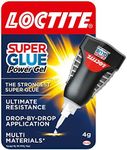Buying Guide for the Best Metal Glues
Choosing the right metal glue is crucial for ensuring strong and durable bonds between metal surfaces. Metal glues are used in a variety of applications, from DIY projects to industrial repairs. The key to selecting the best metal glue is understanding the specific requirements of your project, such as the types of metals involved, the conditions the bond will be exposed to, and the desired strength and flexibility of the bond. By considering these factors, you can choose a metal glue that will provide a reliable and lasting solution.Bond StrengthBond strength refers to the ability of the glue to hold two surfaces together under stress. This is important because it determines how well the glue will perform under load or pressure. Bond strength is usually measured in pounds per square inch (PSI). For light-duty applications, a lower PSI may suffice, while heavy-duty applications require a higher PSI for a stronger bond. Consider the weight and stress the bonded materials will endure to choose the appropriate bond strength.
Cure TimeCure time is the duration it takes for the glue to fully set and reach its maximum strength. This is important because it affects how quickly you can use or handle the bonded item. Cure times can range from a few minutes to several hours or even days. If you need a quick fix, opt for a fast-curing glue. For projects where time is not a constraint, a longer cure time might be acceptable and can sometimes result in a stronger bond.
Temperature ResistanceTemperature resistance indicates how well the glue can withstand extreme temperatures without losing its bonding properties. This is crucial for applications where the bonded materials will be exposed to high heat or cold. Glues with high temperature resistance are suitable for automotive or outdoor applications. Consider the environmental conditions the bond will face to ensure the glue can handle the temperature extremes.
FlexibilityFlexibility refers to the ability of the glue to maintain its bond while allowing some movement between the bonded surfaces. This is important for applications where the materials may expand, contract, or move slightly. Flexible glues are ideal for dynamic environments where some movement is expected. If the bonded materials will remain static, a less flexible glue may be sufficient.
Chemical ResistanceChemical resistance is the glue's ability to withstand exposure to chemicals without degrading. This is important for applications where the bond may come into contact with oils, solvents, or other chemicals. Glues with high chemical resistance are suitable for industrial or automotive use. Consider the chemical environment the bond will be exposed to when selecting a glue with the appropriate resistance.
Application MethodThe application method refers to how the glue is applied to the surfaces to be bonded. This is important because it affects ease of use and precision. Common methods include squeeze tubes, syringes, or applicator brushes. For small, precise applications, a syringe or brush may be best. For larger areas, a squeeze tube might be more efficient. Consider the size and precision required for your project to choose the right application method.















